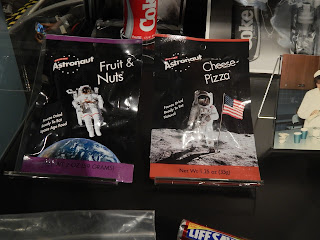Armstrong Air and Space Museum
Wapakoneta, Ohio
High 86 Low 71
It was warmer today with thundershowers forecast for this
evening. It was windy all day.
We went to the Armstrong Air and Space Museum. We are only a
mile from it.
The Museum is named after Neil Armstrong, the first astronaut
to set foot on the moon. He was born in Wapakoneta, Ohio August 5, 1930. The Museum tells about his early life but also give a
history of the early space race between Russia and the United States in the
late 1950s and 1960s.
The museum shares the story of Neil Armstrong, all Ohioans
who have attempted to defy gravity, the Space Race, and current space
exploration. The museum itself is designed to resemble a futuristic moon
base. It is most beautiful when viewed at dusk.
The museum features many one-of-a-kind artifacts including
the Gemini VIII spacecraft, Neil Armstrong’s Gemini and Apollo spacesuits, and
an Apollo 11 moon rock. The museum is also home to two full-size aircraft, both
of which were flown by Mr. Armstrong. A 15-year-old Armstrong learned to fly at
Port Koneta, a long-gone Wapakoneta airfield. He flew a yellow Aeronca Champion
now on exhibit at the museum.
This is no static museum; it is filled with motion and
sound. There are seven interactive exhibits, ten audio/visual elements, and
three simulators. Visitors can practice landing the lunar module and space
shuttle, or docking the Gemini capsule, as Neil Armstrong did in 1966. Adults
will find the simulators just as challenging and entertaining as the kids do.
The 56-foot dome in the center of the museum houses the Astro Theater, a unique
venue that allows guests to enjoy the night sky or watch the 25-minute
documentary about Apollo 11’s lunar landing. There is no additional charge for
the simulators or the film.
Neil Armstrong was a fighter pilot who later joined the race
to set foot on the moon. One display shows the requirements to be an astronaut
which were later change to not over 6 feet tall and not over 35 years old.
We got to see one of the moon rocks that were collected on
the first lunar landing and a piece of the meteor that carved out meteor crater
in Arizona.
There is a replica of Sputnik, the first Russian artificial satellite.
We got to watch a movie about Apollo 11, and the first steps
on the moon. When the lunar lander, Eagle, landed it had less than 30 seconds
of fuel remaining.
Interestingly, dehydrated and freeze dried food was developed first for the space program.
Coke and Pepsi developed ways to drink their beverages in a zero gravity environment.
It was an interesting Museum to see.
Thanks for visiting.





























I always think space/air museums will be boring, yet they always fool me. VERY interesting !!!
ReplyDelete